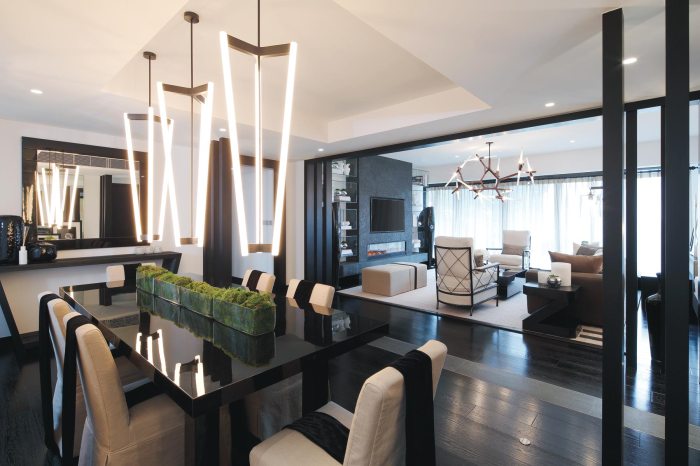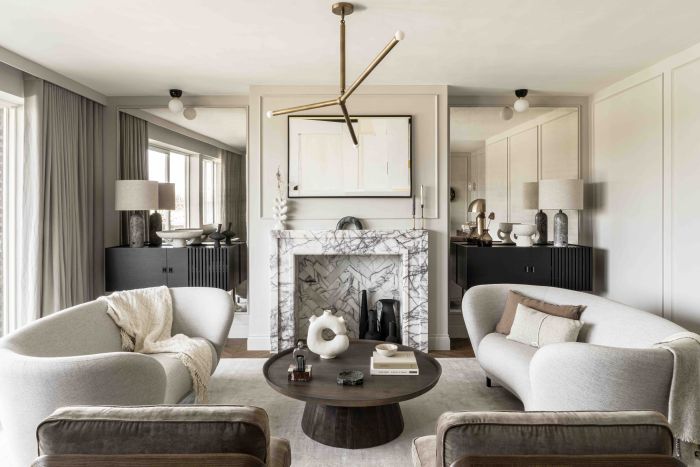Exploring the Best Interior Designers: A Comprehensive Guide
Dive into the world of best interior designers with this captivating guide that delves into the different types, qualities, signature styles, collaborations, projects, and trends in the industry. From famous designers to unique skills, this introduction sets the stage for an informative and engaging read.
As we explore the intricate world of interior design, we uncover the secrets behind what makes the best interior designers stand out in the industry.
Types of Interior Designers
Interior designers can specialize in various areas, each requiring a unique set of skills and expertise to excel in. Here are some common types of interior designers:
Residential Interior Designers
Residential interior designers focus on creating functional and aesthetically pleasing living spaces for homes. They work closely with clients to understand their preferences and design personalized interiors. Famous residential interior designers include Kelly Wearstler and Nate Berkus. Skills required for this specialization include a strong sense of style, space planning, and attention to detail.
Commercial Interior Designers
Commercial interior designers specialize in designing spaces for businesses, offices, retail stores, and other commercial establishments. They are skilled in creating environments that are conducive to productivity, branding, and customer experience. Examples of notable commercial interior designers are David Rockwell and Philippe Starck.
Key skills for this specialization include knowledge of building codes, space optimization, and project management.
Hospitality Interior Designers
Hospitality interior designers focus on creating inviting and functional spaces for hotels, restaurants, resorts, and other hospitality venues. They aim to enhance the guest experience through thoughtful design and attention to detail. Well-known hospitality interior designers include Adam Tihany and Kelly Hoppen.
Skills needed for this specialization include knowledge of hospitality industry trends, space planning for guest comfort, and expertise in sourcing durable and stylish materials.
Healthcare Interior Designers
Healthcare interior designers specialize in designing healthcare facilities such as hospitals, clinics, and medical offices. They prioritize creating environments that are safe, hygienic, and calming for patients and healthcare professionals. Renowned healthcare interior designers include Jain Malkin and Cheryl Durst.
Unique skills required for this field include knowledge of healthcare regulations, infection control measures, and creating spaces that promote healing and well-being.
Green/Sustainable Designers
Green or sustainable interior designers focus on creating environmentally friendly and energy-efficient spaces. They incorporate eco-friendly materials, energy-saving technologies, and sustainable practices into their designs. Examples of prominent green interior designers are Jamie Durie and Victoria Meale. Skills needed for this specialization include knowledge of green building standards, sustainable sourcing, and a commitment to reducing environmental impact through design choices.
When it comes to the best interior designers, there are key characteristics that set them apart from the rest. These qualities are not only reflected in their work but also play a crucial role in their success. One of the most important qualities of the best interior designers is their creativity. They have a unique ability to envision spaces in ways that others may not think of. This creativity allows them to come up with innovative design solutions that can transform a space into something truly extraordinary. Another essential quality is their impeccable attention to detail. The best interior designers leave no stone unturned when it comes to designing a space. They pay close attention to every element, from the color palette to the furniture selection, ensuring that every aspect of the design is carefully curated to perfection. Effective communication with clients is also a hallmark of the best interior designers. They take the time to listen to their clients' needs and preferences, ensuring that the final design not only meets but exceeds their expectations. Clear communication helps build trust and ensures a successful collaboration between the designer and the client. Interior designers are known for their unique signature styles that set them apart from others in the industry. These designers have not only influenced the way spaces are designed but have also left a lasting impact on the industry as a whole. Let's explore some of the signature styles of renowned interior designers and how they have shaped the world of interior design. 1. Minimalist Elegance Renowned for their clean lines, neutral color palettes, and focus on simplicity, minimalist designers like John Pawson and Axel Vervoordt have revolutionized the concept of elegance in interior design. Their approach emphasizes the use of natural materials and a less-is-more philosophy, creating spaces that are both sophisticated and timeless. 2. Eclectic Bohemian Designers like Kelly Wearstler and Justina Blakeney have made a name for themselves with their eclectic bohemian style, blending bold colors, patterns, and textures to create vibrant and eclectic spaces. Their fearless approach to mixing and matching different elements has inspired a new wave of creativity in interior design. 3 Interior designers such as Jonathan Adler and Kelly Hoppen are known for their modern glamour style, combining luxurious materials, sleek finishes, and a touch of drama to create spaces that exude sophistication and opulence. Their designs often feature bold accents, metallic finishes, and statement pieces that elevate the overall aesthetic. 4. Scandinavian Simplicity The Scandinavian design aesthetic, popularized by designers like Ilse Crawford and Norm Architects, is characterized by its emphasis on functionality, minimalism, and a connection to nature. These designers often use light colors, natural materials, and clean lines to create spaces that are both cozy and contemporary. 5. Classic Elegance Designers such as Jacques Garcia and Victoria Hagan are known for their classic elegance style, which combines traditional elements with a modern sensibility. Their designs often feature rich textures, ornate details, and a sense of grandeur that harkens back to a bygone era of sophistication and luxury. Collaborations and projects play a crucial role in the success of interior designers, allowing them to showcase their creativity and expertise in various spaces. By working with other professionals and taking on iconic projects, top interior designers have been able to leave a lasting impact on the industry. Successful collaborations between interior designers and architects, contractors, and artisans have resulted in the creation of unique and innovative spaces. By combining their skills and knowledge, professionals from different fields can bring a project to life in ways that wouldn't be possible individually. These collaborations often lead to the development of cutting-edge design concepts and solutions that set trends in the industry. Top interior designers have undertaken iconic projects in residential, commercial, hospitality, and other sectors. From luxury homes to boutique hotels, these projects showcase the designer's signature style and attention to detail. By working on high-profile projects, interior designers can gain recognition and elevate their reputation in the industry. Iconic projects also serve as a testament to the designer's talent and ability to transform spaces into stunning works of art. Collaborations and projects contribute significantly to the success of an interior designer by providing opportunities to showcase their skills, expand their portfolio, and build relationships with clients and industry professionals. By taking on diverse projects and collaborating with experts in the field, interior designers can continue to grow and evolve in their craft. Additionally, successful projects serve as a testament to the designer's capabilities and help attract new clients and opportunities for future endeavors. In the ever-evolving world of interior design, keeping up with the latest trends is crucial for staying relevant and innovative. Top interior designers are always on the lookout for new ideas and concepts to incorporate into their projects. Let's take a closer look at the current trends shaping the industry and how designers are adapting to them. One major trend in interior design is the incorporation of nature indoors. Designers are bringing the outdoors in by using natural materials like wood, stone, and plants to create a sense of tranquility and connection to the environment. Another popular trend is the emphasis on minimalism and functionality. Clean lines, simple color palettes, and multi-functional furniture are all key elements of this trend. Designers are focusing on creating spaces that are not only aesthetically pleasing but also practical and efficient. Technology is playing a significant role in modern interior design trends. Smart home systems, automated lighting, and integrated sound systems are becoming more common in residential and commercial spaces. Designers are finding creative ways to incorporate technology seamlessly into their designs. The focus on sustainability and eco-friendly design is another important trend in the industry. Designers are using recycled materials, energy-efficient lighting, and environmentally friendly products to reduce their carbon footprint and create healthier living environments. This trend is not only good for the planet but also for the well-being of the occupants. In conclusion, the realm of interior design is vast and ever-evolving, with top designers constantly pushing boundaries and setting new trends. The impact of these creative minds reverberates throughout the industry, shaping the spaces we inhabit and the way we perceive design. What are the different types of interior designers? Interior designers can specialize in residential, commercial, hospitality, or sustainable design, each requiring unique skills and expertise. What qualities distinguish the best interior designers? The best interior designers possess creativity, attention to detail, strong communication skills, and the ability to understand and fulfill client needs. How do collaborations contribute to an interior designer's success? Collaborations with architects, contractors, and other professionals allow interior designers to execute large-scale projects effectively and bring diverse expertise to the table. What current trends are shaping the interior design industry? Modern interior design trends are influenced by technology, sustainability, and a focus on creating spaces that are both functional and aesthetically pleasing. Creativity
Attention to Detail
Client Communication Skills
Signature Styles of Top Interior Designers

Collaborations and Projects

Successful Collaborations
Iconic Projects
Contribution to Success
Trends in Interior Design
Incorporating Nature Indoors
Minimalism and Functionality
Technology Integration
Sustainability and Eco-Friendly Design
Ultimate Conclusion
Detailed FAQs




